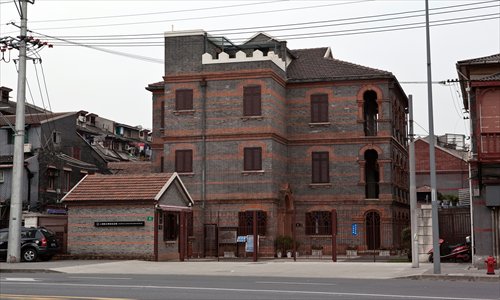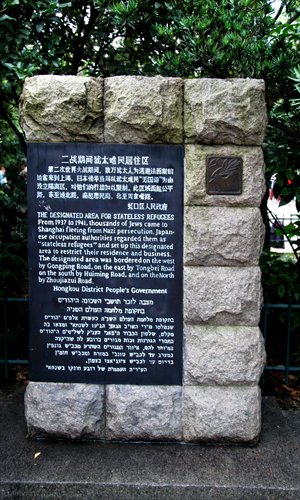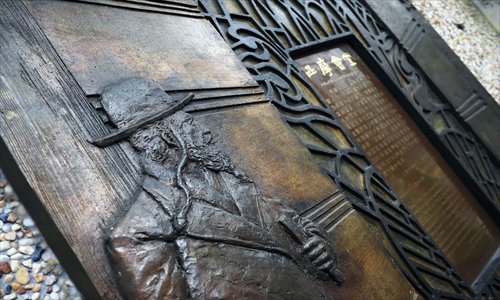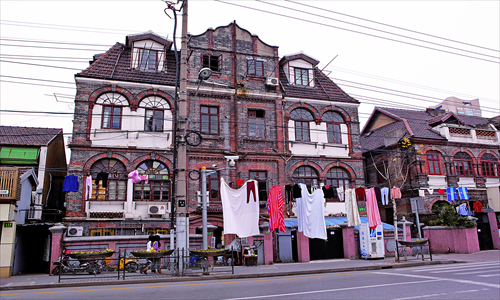Life in the ghetto

Today's Huoshan Park (Wayside Park), an exquisite little patch of green in the southeastern part of Hongkou district, is where one can catch Chinese men and women doing their morning exercises, strolling or taking their birds for a walk. In the 1930s and 1940s it would have presented a very different scene. In those days the park was the heart of the Shanghai Ghetto, "the Designated Area for Stateless Refugees" as it was formally known. It was then the only place where the 20,000 or more European Jews, who were crammed together in Hongkou district, could gather and relax and get some fresh air. Just around the corner on Changyang Road stands the former Ohel Moshe Synagogue, now the Shanghai Jewish Refugees Museum.
A memorial in the park reminds visitors, in Chinese, English and Hebrew, of this short but fascinating piece of history - between 1937 and 1945 Hongkou district was a haven for European Jews fleeing Nazi Germany. In those days the Japanese army-occupied Shanghai was the only destination in the world that would accept refugees without visas. More Jews found sanctuary in China than in any other country in the world then.

Already settled
Before the arrival of the Jewish refugees, two Jewish communities had already settled in the city. They were Baghdadi Jews, who had already made fortunes in India and, after they arrived in Shanghai, helped pushed the sleepy port town to the forefront of international trade. The most famous included the Sassoon family, which had been based in Iraq but later spread to India, China and England and became one of the wealthiest families in the world; and the Kadoories and the Hardoons, who amassed enormous wealth and became leading members of Shanghai's financial elite.
The Baghdadi community numbered nearly 1,000, Steve Hochstadt's book Exodus to Shanghai records. They practiced Sephardic Judaism and established their own school, the Shanghai Jewish School, next to the Ohel Rachel Synagogue in the International Settlement, which can still be found on today's Shaanxi Road North.
At the beginning of the 20th century, Shanghai's Jewish community saw another wave of Jewish refugees arrive, fleeing from anti-Semitic persecution, pogroms and revolutionary upheaval in Czarist Russia. Many of them gathered in communities in the French Concession and in Hongkou district, opening small businesses, although they were not as well-off as the Baghdadi Jews. There were about 5,000 and together with the Baghdadi Jews, they would later find themselves helping the desperate European Jewish refugees who made it to Shanghai.
After Hitler and the Nazis took control in Germany, the state-sponsored anti-Semitic persecution drove thousands of Jews to seek asylum abroad, but few countries were open for Jewish immigration.
Jew wanting to leave Europe however still needed visas. Thousands of Jews got their visas from He Fengshan, the then Chinese consul general in Vienna who has been dubbed the Chinese Schindler. His compassion and sympathy towards the Jews prompted him to issue visas for them whenever he was approached, despite the Chinese ambassador in Germany forbidding this, wanting to strengthen his country's relationship with Germany. But he managed to issue 1,200 visas in his first three months as consul general. Many used their visas to flee to Shanghai, while others used the visas to escape to Palestine, the US and even Cuba.
Shanghai was a lesser known and unlikely haven during World War II. The Japanese, who controlled Shanghai's customs, post and telegram services, were allies with the very nation that sought to eliminate the Jews in Europe, but they made no effort to stop the massive influx of Jews to Shanghai. Commentators said this ploy was intended to exploit the Jews' financial and political influence to assist Japan in its war moves elsewhere.
According to Exodus to Shanghai, before the arrival of the refugees, "the Baghdadi Jewish community created a relief committee headed by Paul Komor, the Honorary Consul General for Hungary, to greet the refugees, provide temporary housing, and integrate them into the Shanghai economy. The Sassoon and Kadoorie families used their wealth and influence to smooth the descent of these Europeans into refugee status. Many in the Russian Jewish community offered assistance as well, though more on an individual basis."

Fed by charity
At first, not all the Jewish refugees lived in Hongkou district. Those who came first and who brought valuables to Shanghai rented apartments in the International Settlement, and made a living by working or opening businesses in the city. The less fortunate had to live in Hongkou district, the poorest area in Shanghai at the time. They survived by selling their belongings and eating the one free meal a day offered by the charities funded by the Baghdadi Jews.
They created their own community and café life on the streets of Hongkou, opening Western restaurants, bread shops, bars and cafés on today's Zhoushan Road and Huoshan Road. It wasn't long before they developed their own cultural groups offering regular entertainment, plays, concerts and art exhibitions. According to Exodus to Shanghai, by late 1939, there were monthly productions of plays in German many related to refugee life. Jewish newspapers also emerged, and the Shanghai Jewish Youth Association School was opened.
The international situation worsened in 1940. On September 27, Japan signed the Tripartite Pact with Germany and Italy, and at Germany's insistence, the Japanese government began revising its policies for Jews.
The Baghdadi Jews were the first to suffer. After the Japanese attacked Pearl Harbor in 1941 and Asia became a major front in World War II, thousands of Americans, British, and Dutch people from the Allied countries living in Shanghai found their countries suddenly at war with Japan, including the Baghdadi Jews who were mostly British. They lost their jobs and then their freedom when the Japanese sent them to internment camps for Allied civilians.
On February 18, 1943, the Japanese authorities in Shanghai officially proclaimed "the Designated Area for Stateless Refugees" in Hongkou district. The zone was in today's Tilanqiao area, bordered on the west by Gongping Road, to the east by Tongbei Road, and south and north by Huiming and Zhoujiazui roads. The proclamation demanded that all "stateless refugees," as the German and Austrian Jews were referred to, move their residences and places of business to inside the designated area by May 18, 1943.
The 20,000 Jewish refugees moved into the overcrowded area which became known as the Shanghai Ghetto. However, the area bore little resemblance to the Nazi ghettos and concentration camps in Europe. Although the Jewish refugees in the ghetto were under strict supervision, unlike the imprisoned Allied nationals in Shanghai, they were allowed to leave the designated area as long as they carried permits issued by the Japanese authorities. Also, unlike in Nazi-dominated Europe, the Jews in Shanghai were never forced to labor, nor did they face the threat of extermination. Conditions in the Shanghai Ghetto were far from ideal but the Jews did not suffer their ordeal alone. The ghetto was also home to many Chinese and Russians, who lived alongside the refugees. In Europe, genocide was being practiced daily.
Even so malnutrition and disease were prevalent in the ghetto as many families had by then sold all the valuables they had brought with them and lost their sources of income. According to Escape to Shanghai, a book by James R. Ross based on the accounts of 200 survivors who made it to Shanghai, the average daily diet for Jewish refugees in 1943 was simple. For breakfast, they ate gruel, washed down with green tea, and for supper, a piece of bread (often dry and moldy) spread with locally made margarine. A piece of cheese or a slice of salami was an occasional treat.

Unsanitary living
The housing conditions in the ghetto were crowded and unsanitary. Rats and cockroaches were everywhere. People crowded together in those small shikumen houses and shared toilets. There was barely enough space for furniture, and the conditions were particularly depressing for German and Austrian refugees who had been used to cleanliness and order. The lanes were small communities and had few secrets and little privacy. In some the Chinese and the refugees lived together and the Jewish children learned to speak the Shanghai dialect.
Gao Bei's Shanghai Sanctuary noted that Chinese media and academics played a significant role in persuading the locals to help the refugees. As Shanghai was also at the time in a crisis as it struggled with the invading Japanese, the fate of the Jewish refugees was linked to the Chinese who developed a sympathy for the Jews. The Jews also provided an object lesson for the Chinese. An editorial in the major newspaper Shenbao said: "If the Chinese people want to avoid the same sufferings that the Jewish people are experiencing, they must first save their precious homeland ... so that the Chinese will not become the second Jews."
The Jewish refugees didn't suffer too long. The Allied Forces began to bomb Shanghai in 1944, but the ghetto was not seriously damaged. On September 3, 1945, the Shanghai Ghetto was officially liberated and after the liberation, most of the Jewish inhabitants went to British Mandated Palestine (which would become Israel), Australia and the US. Despite the grim living conditions and the allied bombings, almost all of the 20,000 Jews who lived in the Shanghai Ghetto survived.
Today, scores of those who escaped the Holocaust by fleeing to Shanghai still gather regularly, remembering the city and those citizens who helped them when they needed help the most.